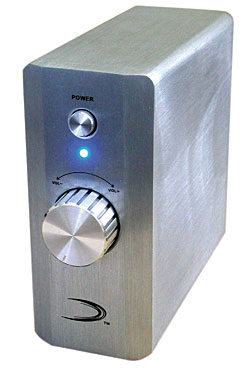| Columns Retired Columns & Blogs |
Sonic Impact Model TA2024 Super T power amplifier
Why don't you review affordable gear?
Readers always pose that question to Stereophile, and it doesn't matter what we think affordable means—to a large percentage of our readers (or at least of our letter-writers), we don't get it.
 So when a Forums participant put the question to John Atkinson last winter our fearless leader responded along the lines of "Like what?"
So when a Forums participant put the question to John Atkinson last winter our fearless leader responded along the lines of "Like what?"
"Like the $39 Sonic Impact power amplifier. It's surprisingly good—and not just for the money."
Well, $39 is affordable by any definition, and John's response was immediate. "I ordered one. I'll report my impressions."
Time went by. It wasn't that JA didn't want to listen to the little amp that was causing all the buzz (unfortunate choice of words); it's more that his life is controlled—nay, oppressed—by deadlines. Listening for "fun" has become a distant memory. One afternoon, as the two of us plotted how to get the mighty Canton Vento Reference 1 DCs over to his test lab, an optimistic expression flitted across John's face.
"If only we had a product you could carry home in one hand that you could review this month...why, oh yes, I do believe I have something that fits the bill right on my bench."
"Now hold on, hoss," I said. "Don't you try to palm off none of that cheap hi-fi on me—I'm on to your tricks!"
"I wouldn't do that to you, Wes. Sonic Impact sent me their upgraded, $159 model. You can review that."
Heh-heh. In the end, I got mine. The Model TA2024 Super T amplifier has proven to be so much fun and so full of surprises that John's been waiting on my copy long past the deadline.
Never lose your sense of the superficial
If $159 isn't affordable enough for you, you can buy the base model for $39, but you'll need to add a 12V DC power supply (or batteries), and you won't get the nice aluminum case, higher-quality RCA inputs, or five-way binding posts. And no, I'll tell you up front that I haven't compared the upgrade against the plain-vanilla model. Sonic Impact says it made changes based on the feedback of its audiophile customers, and that Tripath made more than 14 modifications to its chip (see below), so you're not simply paying extra for the audio jewelry.
So what the heck is this thing? Basically, it's a simple class-D power amplifier based on the Tripath TA2024 chip. According to Tripath's data sheet, the TA2024 produces 11W into 4 ohms or 6W into 8 ohms—and that's what Sonic Impact claims, too.
The TA2024 is 7.25" H by 3.5" W by 7.5" D, and its narrow front panel is dominated by a huge, central volume knob, a smaller power button, and a blue power LED. The sides of the case are unadorned, and the rear panel sports a DC input, two RCA inputs, and the two five-way binding posts—and some perforations, presumably for ventilation, although the TA2024 shouldn't need much of that at a claimed efficiency of 81% at 11W into 4 ohms.
What else do you get? A simple switching wall-wart power supply, a cable that lets you run the TA2024 off your car battery, and some "gimme" speaker cable. What did you want for $159?
The Super T isn't so much an integrated amplifier as a power amp with a volume pot—you get no source switching or buffering, neither of which seems crippling given its proposed use of providing affordable, easily portable power amplification.
People think it must be fun to be a supergenius, but they don't realize how hard it is to put up with all the idiots in the world
The first thing I did was plunk the Super T right in the middle of the system I'd been reviewing: Canton Vento Reference 1 DC speakers, Conrad-Johnson CT-5 preamp, and my trusty Ayre C-5xe universal player. Wired with Stereovox's Colibri interconnect and Firebird speaker cable, my system didn't even have a cable that cost as little as the TA2024. Heck, my Furutech wall socket cost more!
That might seem unfair, but my custom is to introduce only a single variable, then play around with more over time. It's not so much that I'm scientific as that I have OCD and I must do things a certain way. Otherwise, the world will come to an end, and an audio review just isn't worth that.
So I maxed the Super T's volume knob, using the CT-5 as source selector and volume control, and cued up "The Mooche," from the Jerome Harris Quintet's Rendezvous (CD, Stereophile STPH013-2).
- Log in or register to post comments




































